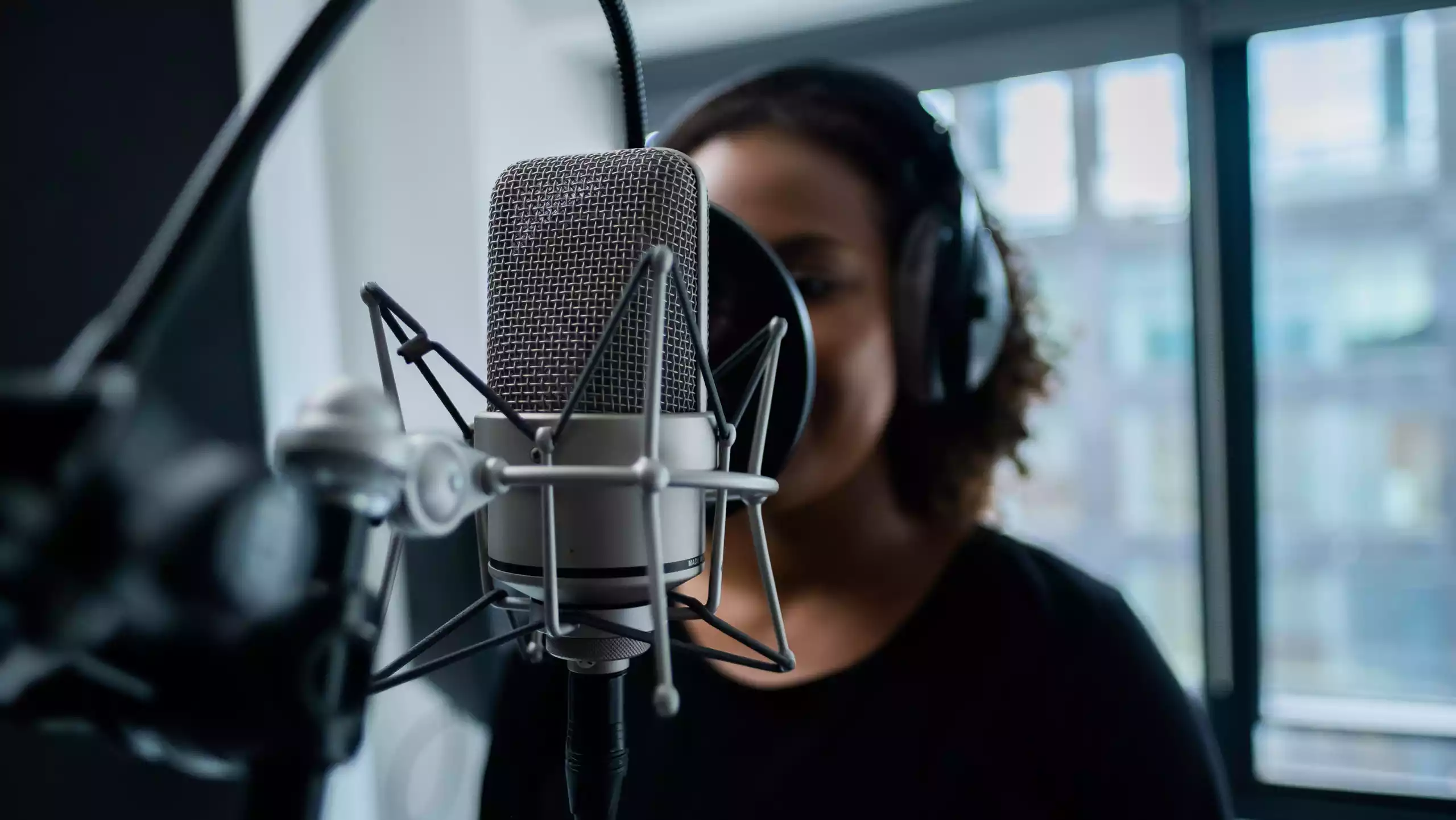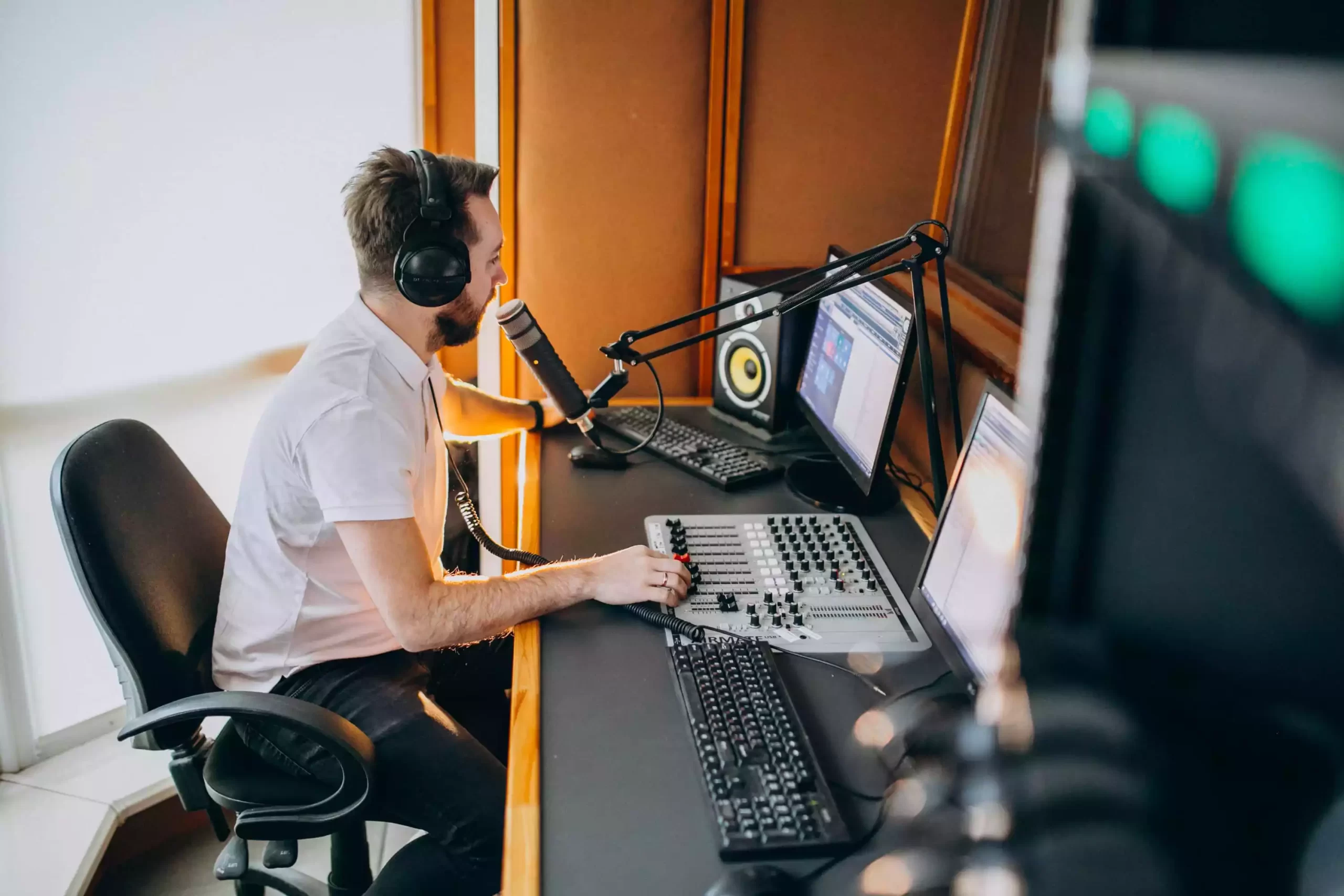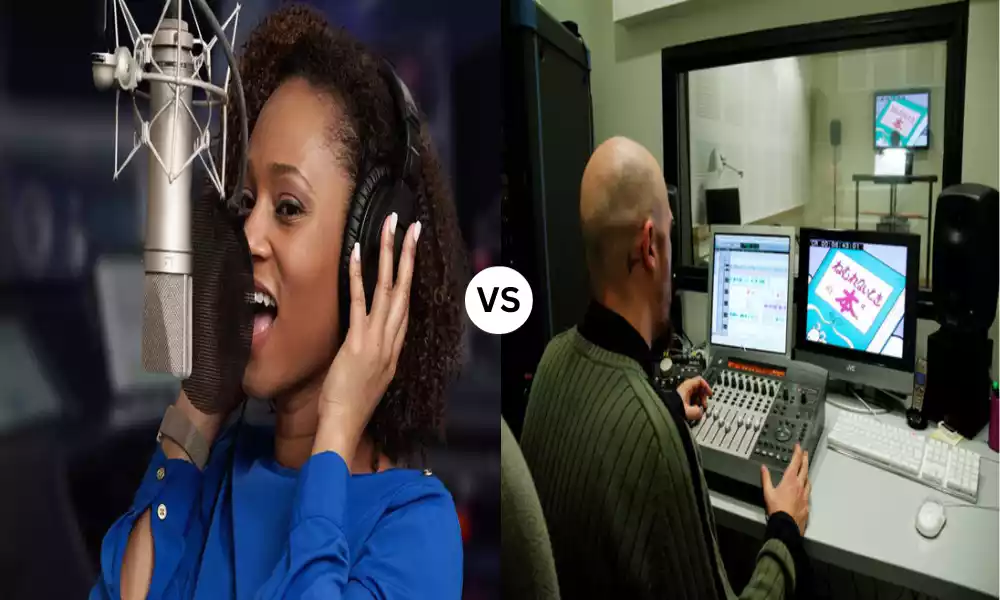Voice Over and Dubbing are integral techniques in the world of audio-visual media, designed to bridge linguistic and cultural gaps for audiences worldwide. Voice over, often used as a narrative tool, overlays an additional voice onto existing audio, providing context or added information without overshadowing the primary sound. Dubbing, on the other hand, involves replacing the original spoken content with a new language or dialect, aiming to offer a fully localized experience for non-native viewers. Both methods, although distinct in nature, serve the common purpose of enhancing audience engagement and ensuring content resonates on a global scale.
What is Voice Over?
Voice over is a production technique in which a non-diegetic voice is used in a radio, television, film, theatre, or other presentation. This voice belongs to an unseen narrator or character, who provides commentary, narration, or translation, and it is played over the primary audio track. The voice over does not replace the original audio but usually plays alongside it or at specific intervals.

Characteristics of Voice Over
- Non-diegetic Sound: Voice over is typically a non-diegetic sound, meaning it is not a direct part of the narrative or the on-screen world. It’s an external commentary or narration.
- Unseen Narrator: The voice-over artist or narrator is usually not visible on-screen while delivering the lines, differentiating VO from on-screen dialogues.
- Layered Sound: Unlike dubbing, where the original sound is replaced, VO is usually added over or alongside the existing audio track.
- Narrative Function: Voice overs often serve a narrative function, guiding the audience through the story, providing background information, or giving context.
- Emotion and Tone: A voice-over can set the mood or tone of a piece. Whether it’s a whimsical narration in a children’s program or a solemn commentary in a documentary, the VO’s tone plays a crucial role.
- Variability in Form: VO can vary from a continuous narration (as in nature documentaries) to intermittent commentary (as in reality shows).
- Scripted Content: Typically, voice overs are scripted. The content is pre-written to ensure that the narration is coherent, concise, and serves its intended purpose.
- Diverse Applications: While often associated with documentaries and news reports, voice overs are used in various media, including commercials, animations, video games, e-learning modules, and even corporate presentations.
- Specificity in Delivery: Given that the voice over is solely an auditory experience for the audience, voice actors need to be very precise in their diction, pacing, and emotive delivery to convey the intended message or feeling.
- Multilingual Use: In some contexts, especially news broadcasting or documentaries, voice overs are used to provide a translation of dialogues spoken in a different language, allowing the audience to hear the original dialogue faintly in the background.
- Technical Aspects: VO recording typically requires a controlled environment to achieve clear sound. This means professional studios, high-quality microphones, and soundproofing are often involved in the process.
Voice overs play a significant role in enhancing the storytelling experience by providing context, emotion, or supplementary information to the main content. Its characteristics make it a versatile tool in various media forms.
Applications of Voice Over
- Documentaries: VO is extensively used in documentaries to provide narration, explaining events, giving context, or presenting facts to the viewers.
- Commercials/Advertisements: Many commercials use voice overs to relay product information, tell a short story, or convey the brand message to viewers.
- Animation: Animated movies and series often rely on voice-over artists to bring characters to life, as the characters themselves are digitally created and do not have “real” voices.
- E-learning Modules: Educational videos, online courses, and training materials frequently use voice overs to explain concepts, guide learners, or provide instructions.
- Radio: Radio shows, dramas, and advertisements utilize voice overs for content delivery, especially when there are no visual cues.
- Audiobooks: Voice-over artists narrate books, allowing users to “listen” to books rather than read them. This is particularly popular for visually impaired audiences or those who prefer auditory learning.
- Video Games: Characters in video games are voiced by voice-over artists. These artists give depth, emotion, and distinct personalities to in-game characters.
- Corporate Presentations: Businesses often use voice overs in corporate videos, product demos, or presentations to explain data, guide viewers through content, or introduce new initiatives.
- Interactive Voice Response (IVR): The automated voices you hear when you call customer service lines or helplines are typically voice-over recordings.
- Film: In some films, a character might narrate the story retrospectively or provide commentary, even if they aren’t on screen.
- News Reporting: Especially in segments where foreign languages are spoken, voice overs provide translations or summaries of the spoken content for the audience.
- Podcasts: While podcasts are primarily conversational, some storytelling or investigative podcasts use voice overs to present facts, narrate events, or introduce segments.
- Trailers and Promos: Movie and series trailers often use voice overs to give a brief overview of the story or to highlight the main attractions.
- Mobile and Web Apps: VO guides users through app functionalities or provides auditory feedback.
- Museum and Art Gallery Audio Tours: Visitors can listen to narrated descriptions of exhibits through headphones, enhancing their experience.
- Public Announcements: Airports, train stations, and other public venues use voice overs for announcements or to provide information to the public.
These applications underscore the importance and versatility of voice overs across various media and industries. The ability of VO to convey information, set tone, and guide audiences makes it a valuable tool in many contexts.
Advantages of Voice Over
- Maintains Authenticity: VO allows audiences to hear the original audio, which can be crucial in retaining the authenticity of a scene, especially when original ambiance, background noises, or character voices are essential to the experience.
- Flexibility in Presentation: Voice overs can be added without disrupting the flow of the original content, providing additional information, context, or narration as needed.
- Cost-Effective: Compared to dubbing, VO often requires fewer resources. Since it doesn’t demand precise lip synchronization, the recording process can be more straightforward and less time-consuming.
- Useful for Multilingual Content: In instances where the original audio features multiple languages, VO can provide translations or explanations without altering the authenticity of the scene.
- Efficient for Quick Turnarounds: Since voice overs do not require meticulous matching to on-screen lip movements, they can be produced more quickly, making them ideal for content that needs swift localization or explanation, like news broadcasts.
- Enhances Storytelling: VO can add depth to storytelling, with narrators offering insights, backstory, or interpretations that enrich the narrative.
- Broad Application: Voice overs are versatile and can be used in various mediums, from documentaries and films to commercials, e-learning modules, and more.
- Preserves Original Performance: In scenarios where the emotion, tone, or nuance of the original performance is crucial, VO ensures that these aspects are not lost, as they might be in dubbed content.
- Helpful for Accessibility: For audiences with visual impairments, voice overs can provide descriptive narration, making visual content more accessible.
- Allows for Artistic Expression: Narrators or voice actors can bring their unique style and interpretation to the content, adding an extra layer of artistic expression.
- Efficient Use of Visuals: With voice overs, visuals can continue uninterrupted, allowing the audience to absorb both the visual content and the narration simultaneously.
- Enhanced User Experience: In interactive applications, like video games or apps, voice overs can guide users, providing feedback or instructions, thus enriching the user experience.
Voice over offers a range of advantages that can enhance content delivery, preserve the original’s integrity, and provide added layers of context and narration. Its versatility and cost-effectiveness make it a popular choice across various media industries.
Limitations of Voice Over
- Lack of Immersion: Since voice over usually runs alongside or over the original audio, it might not immerse the audience as seamlessly as a well-dubbed piece would.
- Auditory Clutter: When voice over and original audio play simultaneously, it can cause auditory clutter, making it challenging for the audience to focus on or understand either audio stream.
- Loss of Original Nuance: The nuances, emotions, and subtleties present in the original dialogue might get overshadowed or diminished by the voice over.
- Distracting: Especially in dramatic or tension-filled scenes, a voice over can be a distraction and might pull the audience out of the narrative.
- Limited Expressiveness: Since VO typically avoids interrupting the main content too much, it might have a more neutral tone. This can sometimes make it less expressive compared to the original performance.
- Complexity in Multilingual Contexts: When translating dialogues from one language to another, voice over can sometimes sound abrupt or not capture the depth and cultural nuances of the original content.
- Technical Challenges: Achieving a balanced mix between the original audio and the voice over can be technically challenging. There’s a risk of either drowning out the original content or making the VO too subdued.
- Over-reliance: In some instances, especially in documentaries or other informational content, an over-reliance on voice over can make the content feel too “told” rather than “shown,” reducing the impact of visual storytelling.
- Might Not Suit All Content: Certain genres or content types (e.g., musicals or highly emotional dramas) might not be well-suited for voice overs, as they could disrupt the viewing experience.
- Cost and Time: While often less resource-intensive than dubbing, voice overs still require skilled artists, quality recording equipment, and post-production efforts, incurring costs and time.
- Cultural Disconnect: Especially for global audiences, a voice over in one language might not resonate culturally with all viewers, making the content feel distant or less relatable.
While voice over has numerous applications and advantages, these limitations indicate that its use needs to be well-considered and appropriately applied, depending on the content type and target audience.
What is Dubbing?
Dubbing is the process of replacing the original audio track in a film, television show, video, or other multimedia production with a new recording in a different language or the same language, ensuring synchronization with the on-screen actors’ lip movements. This technique is primarily used to make content accessible to audiences in regions that speak a different language or to improve the original audio quality.

Characteristics of Dubbing
- Replacement of Original Audio: One of the defining features of dubbing is the complete replacement of the original dialogue with the new voice recording. This differs from voice over, where the new audio is layered over or alongside the original.
- Lip Synchronization: A key element of dubbing is the effort to synchronize the newly recorded voice with the lip movements of the on-screen actors to ensure the final product feels natural.
- Localization: Dubbing often involves adapting the content culturally, not just linguistically. This means adjusting jokes, idioms, and cultural references so they resonate with the target audience.
- Character Consistency: Dubbed characters should consistently have the same voice throughout a series or film, maintaining the continuity and familiarity for the audience.
- Emotional Parity: An effective dubbing process captures the emotions, tone, and nuances of the original performance, ensuring that the dubbed content emotionally resonates with the audience in the same way.
- Technical Precision: Dubbing requires precise technical adjustments to ensure that the new audio seamlessly integrates with the video. This involves careful sound mixing, audio balancing, and sometimes adjusting the pacing.
- Professionally Trained Voice Actors: Dubbing requires voice actors who can mimic the emotional range, tone, and sometimes even the distinct vocal characteristics of the original actors.
- Script Adaptation: The process often involves script adaptation to ensure that the translation not only fits the lip movements but also conveys the intended meaning within cultural contexts.
- Comprehensive Process: Dubbing isn’t just about translation. It includes scriptwriting, casting, directing, recording, and post-production.
- Variability Based on Language: Due to differences in language structure, pacing, and expression lengths, the dubbing process might vary significantly from one language to another.
- Economic Implications: Dubbing is generally more expensive and time-consuming than subtitle creation, but it’s preferred in markets where audiences are less inclined towards reading subtitles.
- High Dependency on Quality: A poor dub can greatly detract from the viewer’s experience, making the content feel disjointed or inauthentic.
In essence, dubbing is a comprehensive process that aims to replace the original audio in a way that feels natural and resonates culturally and emotionally with the target audience. The characteristics highlight the intricacies and precision involved in delivering a high-quality dubbed experience.
Applications of Dubbing
- Feature Films: One of the primary uses of dubbing is in localizing foreign films for new markets, enabling a wider audience to enjoy movies without the need for reading subtitles.
- Television Series: Shows produced in one language or country are often dubbed in other languages to be broadcasted in different regions.
- Animated Films and Series: Animation, particularly children’s cartoons, are frequently dubbed since younger audiences might find it challenging to read subtitles.
- Video Games: As the gaming industry reaches a global audience, games are often dubbed in multiple languages to provide a more immersive experience for players worldwide.
- Advertisements: Global brands sometimes adapt their commercials for local markets through dubbing to connect more effectively with local audiences.
- Educational Content: E-learning courses and educational videos intended for international or multilingual audiences might be dubbed to cater to non-native speakers.
- Corporate Videos: Businesses operating globally may dub their internal training videos, product demos, or corporate presentations to cater to their employees and stakeholders in different regions.
- Documentaries: While many documentaries opt for subtitles or voice-over narration, some choose dubbing, especially if they aim for deeper immersion or are targeting younger viewers.
- Interactive Apps and Software: Voice-guided applications, particularly those for children or specialized markets, might feature dubbed content for international users.
- Voice Assistants: Devices and applications with voice interaction capabilities, like smart speakers or virtual assistants, might utilize dubbing techniques to cater to different linguistic markets.
- VR (Virtual Reality) and AR (Augmented Reality) Content: As immersive experiences, VR and AR often require localized audio, including dubbed dialogues, to fully engage users from different linguistic backgrounds.
- Dubs for Accessibility: Sometimes, dubbing is used to modify content for audiences with specific needs, such as dubbing content into a simpler language or adjusting the pace for particular demographic groups.
- Music: Songs from movies or shows can be dubbed to fit the narrative when translated. This is especially common in animated content intended for younger audiences.
The extensive applications of dubbing underscore its importance in making content accessible, relatable, and engaging for diverse audiences across various media platforms. Dubbing allows creators to cross linguistic barriers and resonate deeply with global audiences.
Advantages of Dubbing
- Enhanced Viewer Experience: Dubbing offers a seamless viewing experience, allowing audiences to focus solely on the visual content without being distracted by reading subtitles.
- Accessibility: For those who struggle with reading or have visual impairments, dubbed content provides an accessible alternative to subtitled media.
- Cultural Adaptation: Dubbing doesn’t just translate; it often adapts content culturally. This can make foreign content feel more familiar and relatable to local audiences.
- Ideal for Certain Genres: Dubbing is especially beneficial for genres like action films or children’s content, where fast-paced visuals might make reading subtitles challenging.
- Broadens Audience Reach: Dubbing allows producers to tap into new markets, appealing to larger, global audiences who might not engage with subtitled content.
- Preserves Visual Integrity: Since the viewer doesn’t have to split attention between visuals and reading subtitles, they can fully appreciate cinematography, visual effects, and actor performances.
- Tailored for Audience Preferences: Some regions or countries have a strong preference for dubbed content over subtitles due to cultural or historical reasons.
- Increases Commercial Potential: Dubbed versions of movies or TV shows can increase box office collections or viewership ratings in foreign markets, leading to higher revenue streams.
- Adaptability: Beyond just linguistic translation, dubbing can adjust jokes, idioms, or cultural references to resonate better with the target audience.
- Uniformity in Broadcast: For television networks or streaming platforms, dubbed content offers a consistent audio-visual experience, especially in regions where multiple languages or dialects are spoken.
- Greater Engagement for Kids: Children, especially those who are pre-literate, can engage with and understand dubbed content more easily than subtitled media.
- Technical Advancement: Modern technology has made the dubbing process more sophisticated, allowing for better synchronization and voice matching, resulting in high-quality output.
- Comprehensive Localization: In addition to dialogues, dubbing can also localize other audio elements, like songs or background noises, creating a more holistic localized experience.
While dubbing requires significant resources and expertise, its advantages highlight why it remains a popular choice for localizing content. By offering a full immersion experience and adapting content culturally, dubbing can make foreign media resonate deeply with local audiences.
Limitations of Dubbing
- Loss of Original Performance Nuance: Dubbing can sometimes fail to capture the intricate nuances, emotions, and specific voice qualities of the original actors, leading to a diluted or altered performance.
- Expensive and Time-Consuming: The dubbing process, which involves translation, script adaptation, casting, recording, and synchronization, can be resource-intensive in terms of both time and money.
- Cultural and Linguistic Challenges: Achieving a perfect translation that conveys the same meaning, tone, and cultural references can be challenging, sometimes leading to content alterations.
- Lip Synchronization Issues: Perfectly matching the dubbed voice to the lip movements of the on-screen actors can be tricky. Mismatches can distract viewers and break immersion.
- Audience Preference: In certain regions or among specific demographics, there’s a preference for original audio with subtitles over dubbed versions, as they seek authenticity.
- Limited Voice Actor Range: In some languages or regions, there might be a limited pool of voice actors, leading to recognizable voices being overused across various shows or movies.
- Technical Challenges: Achieving the right audio balance, ensuring quality recording, and blending the dubbed voice seamlessly with background sounds and music can be technically demanding.
- Potential for Misinterpretation: Dubbing can sometimes lead to misinterpretations or unintended meanings, especially when idioms, humor, or cultural references are involved.
- Lack of Universal Acceptance: While some viewers might appreciate the effort to localize content, others might view dubbing as a dilution of the original work’s essence.
- Restrictions on Artistic Freedom: Dubbing requires strict adherence to the visual content’s timing and lip movements, which can limit the artistic freedom of voice actors.
- Reduced Market Flexibility: Once content is dubbed in a particular language or dialect, alterations for different regions speaking the same language (but with varied cultural nuances) become challenging.
- Dependency on Quality: The quality of the dub can greatly influence viewer reception. A poorly executed dub can significantly hamper the viewing experience.
While dubbing offers numerous advantages in making content accessible and culturally relevant, its limitations underline the importance of careful consideration, resources, and expertise in the localization process. The challenges posed by dubbing emphasize the need for skilled professionals and meticulous attention to detail.
Comparison Table of Voice Over and Dubbing
Here’s a comparison table outlining the differences between Voice Over (VO) and Dubbing:
| Criteria | Voice Over (VO) | Dubbing |
|---|---|---|
| Definition | An audio narration layered over or alongside the original audio. | The complete replacement of original dialogue with a new voice recording. |
| Primary Use | Narration, explanations, additional information. | Localizing content for foreign markets. |
| Audio Integration | Original audio remains audible, usually at a lower volume or in the background. | Original audio is replaced entirely. |
| Lip Synchronization | Not necessary. | Crucial to match voice with on-screen actors’ lip movements. |
| Localization Aspect | Primarily linguistic. | Both linguistic and cultural. |
| Cost & Time | Generally less time-consuming and cost-effective. | More resource-intensive in terms of time and money. |
| Authenticity Preservation | Original audio is retained, preserving the original scene’s authenticity. | Original voice performances are lost. |
| Technical Complexity | Less complex since precise synchronization isn’t required. | Requires precise audio-video synchronization and sound mixing. |
| Audience Engagement | Can be distracting for viewers not used to hearing two audio tracks simultaneously. | Offers a seamless viewing experience without needing to read subtitles. |
| Applications | Documentaries, news reports, commercials, e-learning modules. | Movies, TV series, animated content, video games, advertisements. |
| Cultural Adaptation | Limited, mostly linguistic adjustments. | Extensive, including jokes, idioms, and cultural references. |
This table provides a concise comparison of the key differences between Voice Over and Dubbing. Both methods serve the purpose of localization and making content accessible to broader audiences, but they have distinct characteristics, applications, and implications.
Conclusion
Voice Over and Dubbing are both pivotal audio techniques in media production, aiming to make content accessible and resonant for diverse audiences. While voice over involves layering a narration or commentary alongside the original audio, offering context or explanations, dubbing entails the complete replacement of original dialogue with a new linguistic or cultural version, thereby localizing the content for different regions.
Voice over retains the authenticity of the original scene, making it popular for documentaries and educational content. In contrast, dubbing, used extensively in movies and TV series, provides audiences with a seamless viewing experience, free from the need to read subtitles. Both methods, though distinct in their execution and application, underline the media industry’s commitment to inclusivity and global reach.



